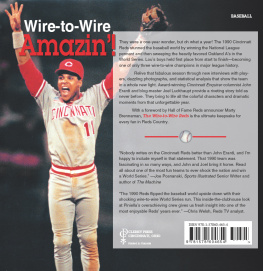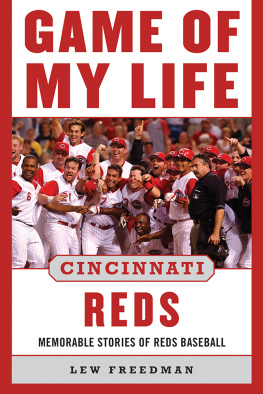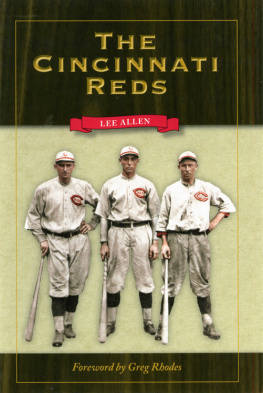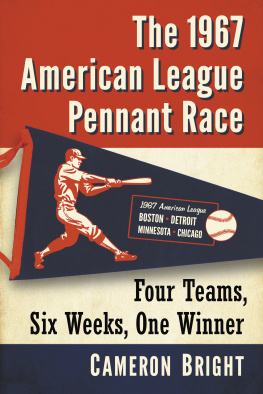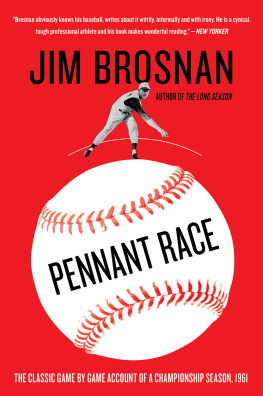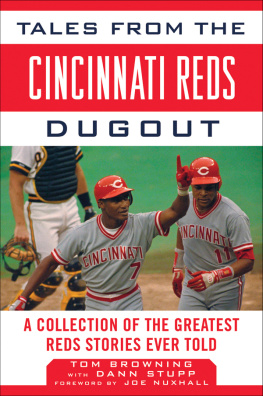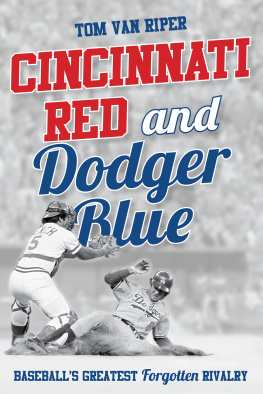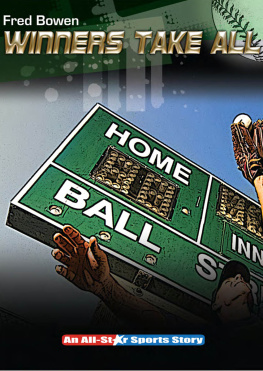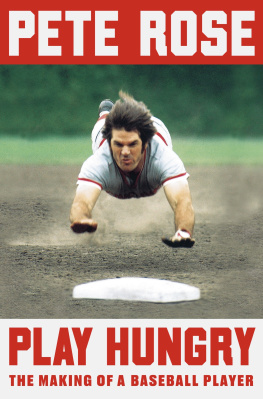

Before the Machine
Copyright 2011 by Mark J. Schmetzer
All rights reserved. No portion of this book may be reproduced in any fashion, print, facsimile, or electronic, or by any method yet to be developed, without express permission of the copyright holder.
Published by Clerisy Press
Printed in the United States of America
Distributed by Publishers Group West
First edition, first printing
For further information, contact the publisher at:
Clerisy Press
PO Box 8874
Cincinnati, OH 45208-08074
www.clerisypress.com
Library of Congress Cataloging-in-Publication Data
Schmetzer, Mark J.
Before the machine: the story of the 1961 pennant-winning Cincinnati Reds / Mark J. Schmetzer.
p. cm.
Includes bibliographical references.
ISBN-13: 978-1-57860-463-0
ISBN-10: 1-57860-463-X
1. Cincinnati Reds (Baseball team)History. 2. World Series (Baseball) I. Title.
GV875.C656S36 2011
796.357640977178dc22
2011007056
Edited by Jack Heffron
Cover designed by Stephen Sullivan
Text designed by Annie Long
All photos in this book, including the cover photos, were taken by Jack Klumpe. They appear courtesy of the Rhodes/Klumpe Reds Hall of Fame and Museum Collection.

To Dad:
I still feel now the anticipation I felt then when seeing in the distance the lights of Crosley Field when you took us to games. Thanks for getting me started in sportsand for knowing the usher who could upgrade our seats.
For my wife, Sharon,
whose 1960 Pirates gave the Reds hope, and for our daughter, Kalli, who still dreams of a championship team all her own.
foreword
Fifty years have passed, and I still remember where I was September 26, 1961in the driveway of our house in Richmond, Indiana, in our 1955 Buick, leaning on the horn with full force. The Cincinnati Reds had just clinched the 1961 National League pennant.
Up and down our usually quiet suburban street, the neighbors were out celebrating this most unexpected triumph. My sister stood in our front yard and banged pan lids together. Other car horns joined in the serenade.
Maybe our little celebration was out of the ordinary, but I doubt it. I suspect such jubilation was repeated throughout Reds countryOhio, Indiana, Kentucky, West Virginia, and nowhere more enthusiastically than in the heart of Cincinnati itself, at Fountain Square, the symbolic center of the city. Thousands of fans spontaneously descended on the Square, where they nearly mobbed the team bus carrying the Reds, who had just returned from winning an afternoon game in Chicago.
The Cincinnati victory, combined with the Los Angeles loss in Pittsburgh around 9 p.m. that evening, made it official: the Reds had won the pennant and would go to the World Series for the first time in twenty-one years.
Youll find all the details from that evening, as well as the rest of that season in this long-overdue tribute to that 1961 team. And more. Mark Schmetzer has captured the mood of the city and Reds fans in this most unlikely of seasons, bring the city of the early 1960s to life. He evokes the experiences we fans recall so wellWaite Hoyts play-by-play, Ed Kennedy and Frank McCormick on the TV broadcasts, the irrepressible Ruth Lyons, the diva of Cincinnati TV in 1961, as she celebrated and promoted the Reds throughout the season.
I have known Mark for many years, but didnt realize until he told me about this book that we shared such fondness for those Ragamuffin Reds. Robinson, Pinson, Coleman, Jay, OToole, Purkey, and, of course, Hutch. The names come flooding back. The memories are still fresh.
Mark traces the arc of the season, the ups and downs of the early months, followed by a push to the lead in early June. But the Dodgers kept it close, and every Reds-Dodgers game seemed pivotal. And those night games from the West Coast? Reds fans lost a lot of sleep that season, and many parents found a transistor radio tucked beneath their kids pillows the morning after those games.
In Before the Machine, we also get a look at the front office and the work of Bill DeWitt, who had just assumed control of the Reds after the death of long-time owner Powel Crosley Jr. in March 1961. The series of moves DeWitt made prior to and during the 1961 seasontrading for Joey Jay, Gene Freese, and Don Blasingame, installing Gordy Coleman at first base, and calling up Johnny Edwards and journeyman pitcher Ken Johnsonall worked beyond anyones expectations. The 1961 Reds improved twenty-six games over the 1960 squad, a remarkable turn-around in the era before free agency.
Cincinnati fans will forever condemn Bill DeWitt for the 1965 trade of Frank Robinson, but this book will help balance out the scales. The Reds dont win the 1961 pennant without Bill DeWitt in the general managers chair. And the foundation he built in his tenure in Cincinnati from 1960 to 1966 ended a dismal sixteen-year stretch in the 1940s and 50s, when the Reds only managed two winning seasons. DeWitt put the Reds on a winning track for four decades. Between 1961 and 2000 the Reds were the winningest team in the National League.
Youll find all this and much more in Mark Schmetzers wonderfully crafted tribute to the 1961 Reds. The ragamuffins deserve it. Rally round the Reds, boys!
Greg Rhodes
Team Historian
Cincinnati Reds
introduction
At first glance, the 1961 National League schedule only looks like it was put together by somebody who had no idea of how to do it.
As it turned out, the league couldnt have done a better job, especially giving the Reds two days off in the middle of the last week of the season. The teamthe town, for that matterneeded every one of the forty-eight hours consumed by September 27 and 28 to recover from its biggest party since V-J Day marked the end of World War II sixteen years earlier.
Everybody in Cincinnati had much to celebrate on September 26, 1961, and they had plenty of time to prepare. The pressure to let off the steam had been building like beer in a shaken-up keg. One day earlier, on September 25, the Reds had flown to Chicago to play one game against the Cubs. Cincinnati, picked by most observers before the season to finish sixth in the National League in 1961, owned a four-game lead over the second-place Los Angeles Dodgers with four games left to play. The Dodgers, though, still had six games to play and remained mathematically alive. If they swept their last six games and the Reds lost their last four, Los Angeles would win the pennant. On the other hand, one more Reds win and one more Dodgers loss would complete what many in Cincinnati and around baseball would consider to be nothing short of a miracle.
It took only the next day the two teams played. The Reds beat the Cubs, 63, at Wrigley Field on Frank Robinsons two-run homer to tie the game in the seventh inning and Jerry Lynchs two-run homer to give Cincinnati a 53 lead in the eighth. Besides coming out of the bullpen to allow one hit with four strikeouts over the final three innings to get the win, relief pitcher Jim Brosnan drove in Robinson with an insurance run in the ninth, and the Reds immediately flew back to Cincinnati.
Meanwhile, the Dodgers had won the first game of a doubleheader in Pittsburgh, 53. The second game still was being played as the Reds plane landed at the airport in Northern Kentucky, where Cincinnati mayor Walt Bachrach and a group of fans greeted the returning heroes. More fans lined both sides of much of the bus route to downtown Cincinnati, creating a parade feeling, and an estimated 30,000 gathered at Fountain Square, making it nearly impossible for the team bus to move more than a few inches at a time.



